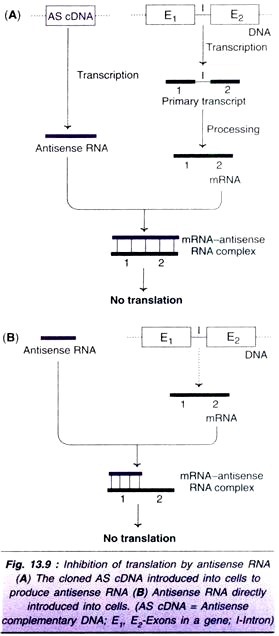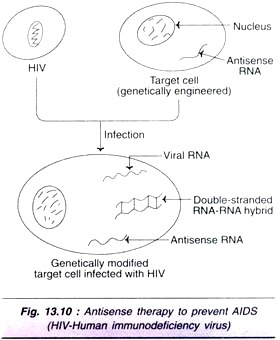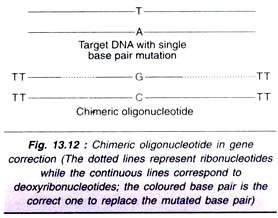ADVERTISEMENTS:
Read this article to learn about the anti-gene and antisense therapy.
In general, gene therapy is carried out by introducing a therapeutic gene to produce the defective or the lacking protein. But there are certain disorders (cancer, viral and parasitic infections, and inflammatory diseases) which result in an overproduction of certain normal proteins. It is possible to treat these diseases by blocking transcription using a single-stranded nucleotide sequence (anti-gene oligonucleotide) that hybridizes with the specific gene, and this is called anti-gene therapy.
Antisense therapy refers to the inhibition of translation by using a single-stranded nucleotide (antisense oligonucleotide). Further, it is also possible to inhibit both transcription and translation by blocking (with oligonucleotides) the transcription factor responsible for the specific gene expression.
ADVERTISEMENTS:
Nucleic acid therapy refers to the use of DNA or RNA molecules for therapeutic purposes, as stated above. The naturally occurring sequences of DNA and RNA (with suitable modifications) or the synthetic ones can be employed in nucleic acid therapy. Theoretically, there is a vast potential for use of nucleic acids as therapeutic agents. But most of the work that is being carried out relates to the use of RNA in antisense therapy.
Some of these are described below:
Antisense Therapy for Cancer:
Oncogenes are the genes responsible for the causation of cancer. The dominantly acting oncogenes can be targeted in antisense technology by using antisense transgenes or oligonucleotides. Antisense oligonucleotides are used for the treatment of myeloid leukemia in as early as 1991.
Antisense RNA molecules are more frequently used in cancer therapy. This approach is effective only if the antisense oligonucleotide (antisense mRNA) specifically binds to the target mRNA and blocks protein biosynthesis (translation). This can be achieved in two ways, as illustrated in Fig. 13.9.
The antisense cDNA can be cloned and transfected into cells. Antisense mRNA is synthesized by transcription. This can readily bind with the specific mRNA and block translation (Fig. 13.9A). The mRNA is actually formed by a gene containing exons and introns through transcription, followed by processing. The other way to block translation is to directly introduce antisense RNA into the cells. This hybridizes with target mRNA and blocks translation (Fig. 13.9B).
The antisense mRNA therapy was tried for the treatment of a brain tumor namely malignant glioma and the cancer of prostate gland. In case malignant glioma, the protein insulin-like growth factor I (IGF-I) is overproduced, while in prostate cancer, insulin-like growth factor I receptor (IGF-IR) protein is more synthesized. For both these cancers, the. respective antisense cDNAs can be used to synthesize, antisense mRNA molecules. These in turn, are used to block translation, as briefly described above and illustrated in Fig. 13.9.
Antisense Therapy for Aids:
Attempts are also being made to prevent HIV infection through antisense therapy. The basic principle is briefly described (Fig. 13.10).
The target cells for HIV infection are genetically engineered to contain a gene that can express a complimentary copy of HIV genome. This gene produces antisense RNA. When the cells containing antisense RNA are infected by HIV, it binds to viral RNA forming double-stranded RNA-RNA hybrid molecules. This double-stranded molecule cannot be used by the enzyme reverse transcriptase. Consequently, a DNA copy of the HIV genome cannot be made and incorporated into the genome.
Antisense Oligonucleotides as Therapeutic Agents:
It is found that oligodeoxynucleotides (with about 15-20 units) can hybridize with specific mRNA and block translation with an ultimate effect of reducing the specific protein. Oligonucleotides can hybridize with different types of RNA transcripts-mRNAs, intron-exons, double-stranded RNAs. The major limitation of using naturally occurring oligonucleotides is that they are degraded by intracellular nucleases.
Certain modifications in the nucleotides (bases or sugars, phosphate) without affecting their hybridization ability have been prepared. However, these modified oligonucleotides are resistant to degradation by nucleases. The most widely used antisense oligonucleotide has a sulfur group in place of the free oxygen in phosphodiester bond. The modified bond is referred to as phosphorothioate linkage.
These phosphorothioate antisense oligonucleotides are resistant to degradation by nucleases, besides being water soluble. Some other modifications of oligonucleotides are with phosphoramidite linkage and 2-0-methyl ribose (Fig. 13.11). The modified antisense oligonucleotides are in fact used as therapeutic agents in the clinical trials for the treatment of certain cancers, bowel disease, AIDS, malaria and viral infections.
The free oligonucleotides do not readily enter the cells. Therefore, they are encapsulated in liposomes for efficient delivery to inhibit the mRNA translation.
ADVERTISEMENTS:
Possible inhibition of smooth muscle cell proliferation:
Proliferation of smooth muscle cells (along with secretion of extracellular matrix) has been implicated in hypertension, failure of coronary bypass grafts, hypertension and atherosclerosis. There exists a possibility of controlling smooth muscle cell proliferation by using antisense therapy.
Chimeric Oligonucleotides in Gene Correction:
Many genetic diseases are due to single base pair mutations. A strategy has been devised to correct such defects by using chimeric oligonucleotides composed of RNA-DNA oligonucleotide with 68 units. This chimeric oligonucleotide has hairpin caps and methylated ribose sugars (at 2nd carbon). The hairpin caps protect the molecule from the degradation by exonucleases while methylated ribose prevents digestion by RNase.
ADVERTISEMENTS:
The correction of a single base pair mutation by using a chimeric oligonucleotide is depicted in Fig. 13.12. The RNA-DNA molecules (chimeric oligonucleotides) bind more readily with duplex DNA and bring about the correction in the mutated base pair.
Aptamers as Therapeutic Agents:
A special type of oligonucleotides that can specifically bind to target proteins and not to nucleic acids is referred to as aptamers. Aptamers are useful as therapeutic agents. For instance, an aptamer that can bind to thrombin inhibits blood clotting. Such oligonucleotides can be used in surgical procedures.
Ribozymes as Therapeutic Agents:
RNA molecules that can serve as enzymes (biocatalysts) are referred to as ribozymes. The naturally occurring ribozymes are to be modified so that they can specifically hybridize with mRNA sequences and block protein biosynthesis (translation).
ADVERTISEMENTS:
There is a limitation however, in directly inserting ribozymes into target cells, as they are easily degraded. This can be overcome by binding ribozyme with an oligodeoxynucleotide. There is a possibility of treating certain cancers and viral diseases by genetically engineered ribozymes.




